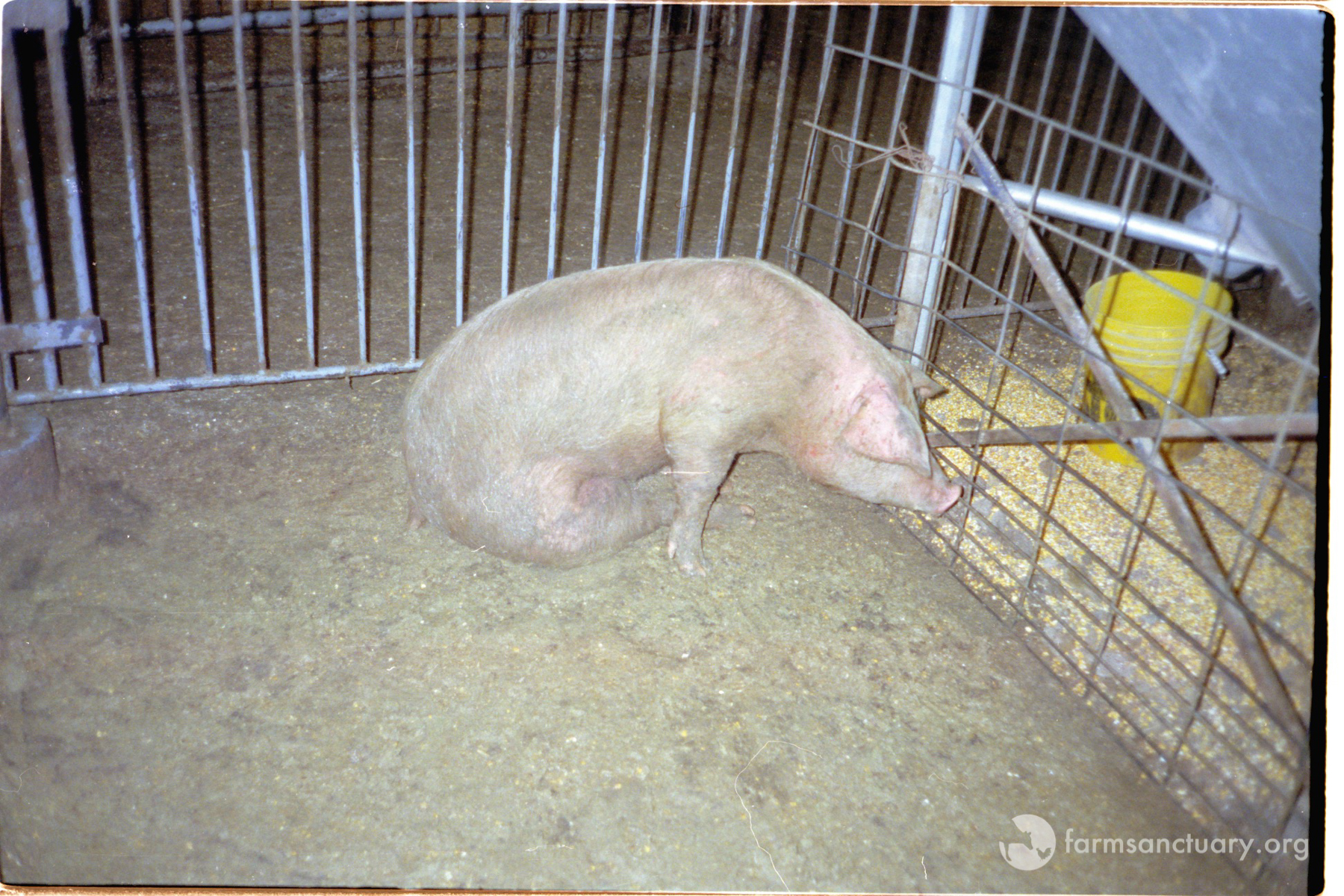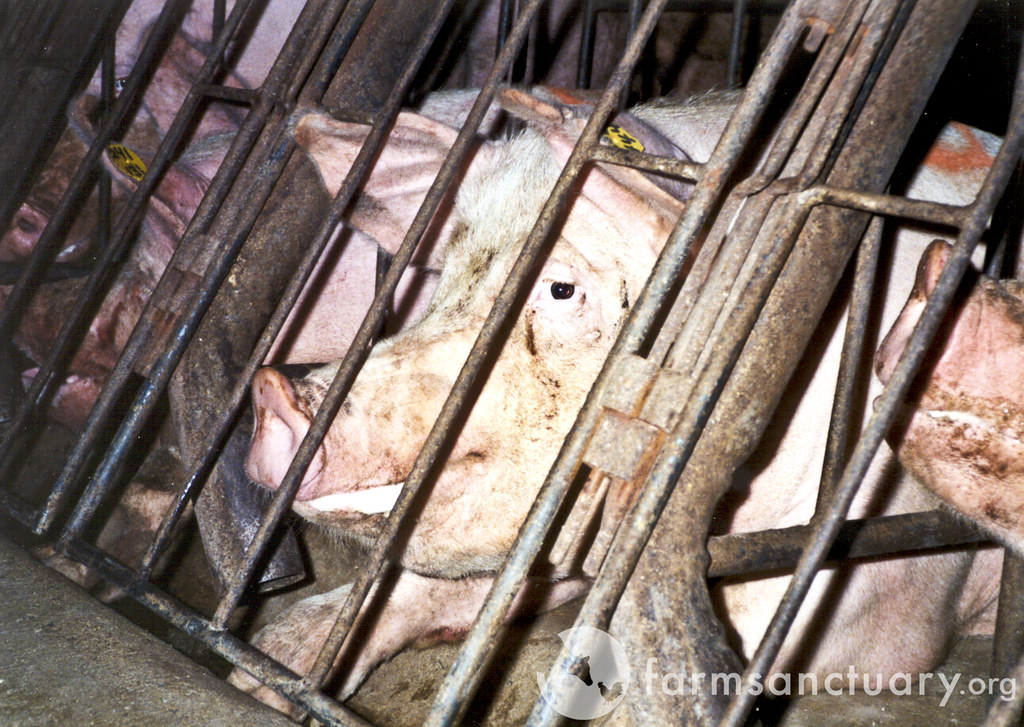What Happens If You Eat A Sick Animal
In light of the Coronavirus, nosotros are seeing first mitt how wildlife trade and meat consumption are related to infectious diseases and the mortiferous take chances it poses to public health. It is therefore critical for governments to enforce stricter welfare standards for commercially-raised animals and ensure food safe is a priority.
Unfortunately, this is non the case.
The biggest Brute protection groups in the country came together and sued Secretary of Agronomics Sonny Perdue and the Department of Agriculture on February eleven, 2020, for declining to protect pigs who are besides ill, downed or injured to walk (also referred to equally nonambulatory disabled or NAD pigs) at slaughterhouses, posing serious risks to animals and human wellness. They are collectively enervating dominion-makers to ameliorate food safety, creature handling, and inspector efficiency at slaughter establishments.
In 2002, Congress amended the Humane Methods of Slaughter Act—which governs not just the slaughter of animals but also their handling at the slaughterhouse—to direct the Secretary of Agriculture to investigate and study to Congress on a host of issues related to nonambulatory livestock, including humane treatment, and to put into effect any regulations needed to protect these animals. Notwithstanding, despite the amended passage of near 2 decades, there is no indication that the USDA has ever reported on nonambulatory pigs, even though pigs incorporate approximately 75% of livestock slaughter in the U.S.
The lawsuit, filed in federal courtroom in Rochester, New York, challenges the bureau's failure to follow Congress's longstanding mandates regarding these "downed" or "non-ambulatory" animals, as well as its recent denial of a petition to ban their slaughter. Plaintiffs are Subcontract Sanctuary, Animal Legal Defense Fund, Animal Outlook, Animal Welfare Constitute, Compassion in Globe Farming, Farm Forward, and Mercy For Animals. They are represented past the Animal Law Litigation Clinic at the Centre for Fauna Law Studies at Lewis & Clark Law School.
Food Rubber and Public Health Risks
124.iv million pigs were slaughtered in the Us in 2018 and we're on track to take a record year for pork product in 2020. Over 4 Per centum or more than one-half a million pigs go far at U.S. slaughterhouses too sick or injured to stand or walk. These animals are often kept in property pens where they are unable to rising from feces-ridden floors before beingness slaughtered. Downed pigs are at a heightened take a chance of carrying a host of human being-transmissible pathogens, including Listeria, Campylobacter, Salmonella, Swine Flu, and Yersinia.
A Pork Manufacture Establish-funded written report found that 53.eight% of nonambulatory pigs were actively infected with H1N1 and 51.9% were actively infected with H3N2. The Centers for Affliction Command and Prevention estimates that the H1N1 pandemic sickened threescore.eight million Americans, hospitalized 274,304, and killed over 12,500.
In addition, pigs who are too sick or injured to stand are far more likely to harbor illness. "Lameness" an abnormality common to NAD pigs causes several bacterial and viral diseases like Listeria which contributes to an estimated 28% of U.S. foodborne illness deaths. Erysipelothrix rhusiopathiae, a bacterial infection that tin can cause human being septic arthritis, endocarditis, and meningitis. Brucellosis, one of the most common zoonotic diseases. Porcine spongiform encephalopathy, the pig equivalent to mad cow affliction. Various other bacterial infections that cause human joint and bone infections, pneumonia, fatal endocarditis, zoonoses for workers, all present every bit lameness in pigs.

Courtesy of Farm Sanctuary
How Inhumane Treatment of Fauna Leads to Disease
Some other major business organisation these groups have is that the slaughter of downed livestock creates an incentive and a heightened risk of inhumane handling, including existence excessively electro-shocked, prodded, kicked, shoved, and dragged by workers attempting to force them to move ― which exceptionally increases illness risk.
In 2009, USDA required that all NAD mature cattle be promptly euthanized because livestock producers may hold sick or injured cattle from slaughter longer which creates incentives to inhumanely force these animals to rise. Notwithstanding, these groups believe that allowing the slaughter of NAD livestock, in fact, encourages inhumane handling of livestock for the same reasons. Producers are incentivized to hold ill or injured cattle from slaughter longer in an endeavor to allow them to sufficiently recover to pass inspection, creating an incentive for establishments to inhumanely force these animals to rise.
Industry studies show that inhumane handling causes pigs to become non-ambulatory. The American Meat Institute cites data showing that 34% of pigs get fatigued when subject to aggressive handling with hot shots. An Elanco Animal Wellness-funded study plant that pigs held in small pens are twice as probable to become not-ambulatory every bit pigs held in large pens. Another study shows that when workers use electric prods on over threescore% of pigs, four times more than pigs become non-ambulatory.
Similarly, inhumane transportation practices cause pigs to go non-convalescent, nevertheless transporters continue to overcrowd pigs in trucks, despite research showing that pigs given 1 more square human foot of space are seven times less likely to become non-convalescent.
Alarm: the video below contains distressing content. Please utilise discretion.
Financial Incentives for Establishments
Establishments have a potent incentive to hold NAD pigs for as long as information technology takes them to rise since a NAD pig that rises is worth at least $38 more a sus scrofa that does not rise ― this increased lairage time will make NAD pigs at least iii-9 times more likely to contract Salmonella.
Establishments want to gain the full slaughter value of the sus scrofa. And even if the pig remains non-convalescent, it is withal worth roughly 70% the value of an ambulatory hog. As a consequence, the prevalence of non-ambulatory pigs has tripled.
"The federal government continues to treat pigs as industrial bolt to be produced equally cheaply every bit possible, without regard for beast welfare or consumer safety," said Irene Au-Young, a student in the Animal Law Litigation Clinic who is representing the plaintiffs. "The law doesn't allow this total disregard, and this lawsuit will hold the government accountable for forcing sick and injured animals to the killing floor and onto the dinner plates of unsuspecting consumers."

Courtesy of Farm Sanctuary
USDA'south Lack of Activeness
FSIS inspector Dr. Dean Wyatt testified before Congress that slaughter establishments screened off unloading areas so that FSIS could not certificate humane treatment violations. He also testified that he had repeatedly been told not to prepare noncompliance records or take other enforcement deportment, even after witnessing workers punching a NAD sus scrofa in the face and nose 8-12 times.
Equally reported verbatim in the complaint:
Subsequently the grunter cruel to the ground, the workers continued to drive another grunter over the top of the nonambulatory pig. The ambulatory grunter began running, trampling the non-ambulatory pig. FSIS suspended the institution, only the adjacent day held the suspension in abeyance, assuasive the establishment to resume operations.
Merely 16 days afterwards, at the same establishment, a worker put a knock hole in a NAD pig's head and loaded the pig—bleeding and fully conscious—into a cart without the FSIS inspector noticing. The worker so wheeled the disabled pig to another pen, where some other worker shackled the pig'south leg and began to drag the conscious pig to the hanging area. At this indicate the inspector intervened, rescuing the pig, which was still rhythmically breathing and blinking her optics, and ensured the pig was euthanized. The inspector and then allowed the pig to be shackled, hung, and processed for human consumption. FSIS reinstated its suspension of the plant, only held information technology in abeyance two working days later, assuasive slaughter operations to resume.
What These Groups Seek
- Prohibit the slaughter of NAD pigs to improve compliance with its nutrient safe and humane handling mandates.
- Ensure that adulterated meat is not sold and that animals are handled in accord with the HMSA.
- There should be no valid reasons for treating NAD pigs differently from NAD mature cattle and veal calves
This reform would reduce the take chances of meat contagion, cease the dubiety well-nigh how to deal with NAD pigs, amend the efficiency of the inspection process, and decrease the multiple incentives for inhumane treatment of animals on farms, during transport, and at slaughter.
How You Can Aid!
Kickoff and foremost, you lot can contact Secretary Perdue and demand better creature welfare standards.
Sign this petition to ban gestation crates and demand improve weather condition for pigs.

Lastly, Reduce Your Meat Consumption to Stay Good for you
Many new diseases are the rise due to factory farming and this is just another reason to reduce animal products from your diet. Pig products keep to face up criticism from top organizations over health concerns. Processed meats have also been linked to cancer . NYC schools have banned processed meats and new legislation in DC is trying to remove it from hospitals . Read more about how factory farming impacts homo health below:
- 4 Shocking Human Illnesses That are Linked to Factory Farms
- The Shocking Truth Well-nigh the Health and Environmental Bear on of Factory Farm Waste
- How Mill Farms Touch on the Communities Where They are Located
- The Dangers of Using Waste From Factory Farms As Fertilizer v years ago
- The Human being Cost of Factory Farming
Yous tin can get healthier past reducing your dairy and meat consumption. Eating more plant-based foods is known to help with chronic inflammation , centre health , mental wellbeing , fitness goals , nutritional needs , allergies , gut health and more ! Dairy consumption also has been linked to many health bug, incl uding acne , hormonal imbalance , cancer , prostate cancer and has many side effects . Nosotros highly recommend downloading the Food Monster App — with over 15,000 delicious recipes it is the largest found-based recipe resource to help reduce your environmental footprint, relieve animals and go healthy! And, while y'all are at it, we encourage you to also learn virtually the environmental and wellness benefits of a plant-based diet .
- Weekly Vegan Meal Plans
- Plant-Based Health Resources
- Plant-Based Food & Recipes
- Establish-Based Nutrition Resources
- The Ultimate Guide to Institute-Based Nutrition
- Budget-Friendly Plant-Based Recipes
- High Poly peptide Constitute-Based Recipes
- Plant-Based Repast Prep
For more Animal, Earth, Life, Vegan Food, Health, and Recipe content published daily, subscribe to the I Light-green Planet Newsletter ! Lastly, being publicly-funded gives usa a greater chance to continue providing you with high-quality content. Delight consider supporting us by altruistic!
Source: https://www.onegreenplanet.org/natural-health/humans-eating-sick-animal-meat-getting-diseases-usda-coronavirus/
Posted by: richmondsheming.blogspot.com



0 Response to "What Happens If You Eat A Sick Animal"
Post a Comment